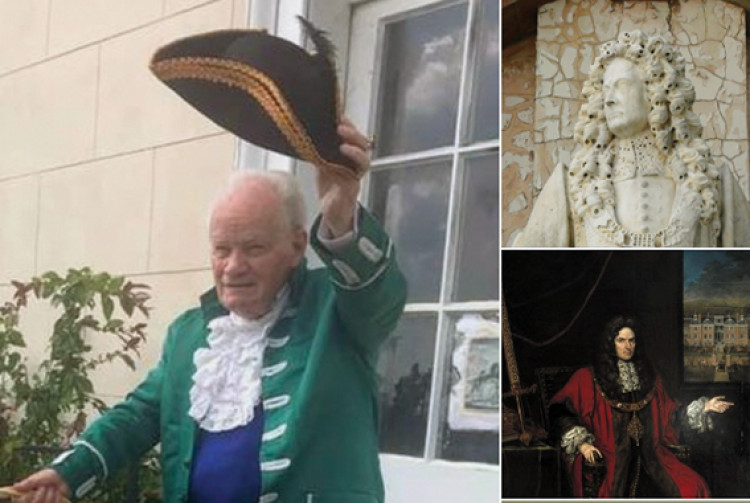Centuries of ownership and history behind High House
By Susan Yates - Nub News contributor 16th Sep 2022
By Susan Yates - Nub News contributor 16th Sep 2022

Nub News occasional columnist Susan Yates, chair of Thurrock Historical Society - gives us a timely lookback at the people involved in the history of High House at Purfleet - where an open day will take place tomorrow.
_____
I WROTE recently about St Clements Church, West Thurrock, where the pilgrims would say a last prayer before catching the ferry across the Thames to continue their journey to Canterbury.
Two of the most interesting features of this church are the magnificent marble, but sadly damaged, effigies of Sir Christopher Holford and his wife Mary, (the coffin underneath is nothing to do with them).
He was born circa 1560 the son of Christopher Holford and his wife Margaret Danyell and died in 1607/8. Mary, his wife, was the daughter of Henry Vyner and Mary Long and she passed away in 1611.
Sir Christopher is a distant relation of the Holfords of Holford Hall, Cheshire and Somerset, and bought the Manor of West Thurrock, known then as High House, in 1607 from Roger and William Owen, the sons of Thomas Owen.

Sir Christopher lived at High House. His heirs were his two sons Christopher and Daniel Holford. Christopher junior died in 1612. Daniel had two daughters Martha who married Sir Cranmer Harris of Creeksea and Mary who married Sir Henry Heyman of Selling, Kent.
Daniel died 23rd February 1629/1630, it was about this time that the dovecote was built. Daniel's daughters were his heirs. It was Martha and Mary who held the manor jointly in 1645.
Mary's son Sir Peter Heyman sold his half of the manor in 1670 to Sir Robert Clayton and John Morris who held the mortgage and in 1677 they bought the other half from Anne Mildmay of Woodham Mortimer the daughter of Martha Harris. After doing some improvements to the house Sir Robert was forced to sell the Manor to Sarah Vandenanker after failing to carry out his responsibilities to repair the sea wall.
Sarah married Benjamin Desborough, a London merchant, and in 1685 the manor was settled on both of them.
At this time the estate comprised approximately 850 acres of which 309 acres were marshland.
High House was originally known as West Hall and in 1066 was held by Earl Harold, later King Harold comprising most of the parish in its 13 hides.
In its next incarnation it was Le Vineyard, because it had a vineyard. It gained the name High House because of its location on the side of a hill overlooking the River Thames and its marshes and its outstanding view. In 1690 the floods caused such extensive damage that it impoverished Benjamin Desborough and in 1694 he was forced to sell part of the manor to a London consortium who repaired the breached sea wall.
In 1697 he sold the remainder of the estate with manorial rights to Caleb Grantham, son of George Grantham of Yorkshire. Caleb died in 1699. He passed the manor to his brother Nathaniel who had three wives.
The first was Mary, daughter of David Lambert, the second Elizabeth, daughter of John Bromwell and the third Mary, daughter of Jacob Croome.
Nathaniel died in 1723. He passed the manor to his son Caleb junior by Mary Lambert.
They were all officers in the navy. Caleb junior in 1750 bought 340 acres of marshland from Robert Hudson and Susanna Beachcroft.
The land included Parsonage Farm and part of Stone House and Tunnel House farms. The young Caleb died in 1762.
The manor then passed to his daughter Mary wife of John Seare who sold it in 1777 to Samuel Whitbread the elder, brewer, who died in 1796. Parsonage Farm had already been sold off. Stone House and Tunnel farms were sold off separately. Samuel Whitbread the younger succeeded his father and he died in 1815.
The estate which in 1839 consisted of 468 acres and remained in the Whitbread family until 1920 when it was broken up.

The High House you see today was built in brick in circa 1677. In 1954 it had been converted into flats. By 1980 it was a house again built in the 17th century in brick with later stucco rendering.
It is interesting to note that Stone House is still remembered in the 21st century in Stonehouse Lane and Stonehouse corner.
High House is now the home of the Royal Opera House and played a part in the rehearsals for the Queen's 70th Jubilee Pageant. It is also, probably more importantly, the headquarters of the High House Community Group who are hosting an open day there tomorrow (Saturday, 17 September).
CHECK OUT OUR Jobs Section HERE!
thurrock vacancies updated hourly!
Click here to see more: thurrock jobs
Share:
















